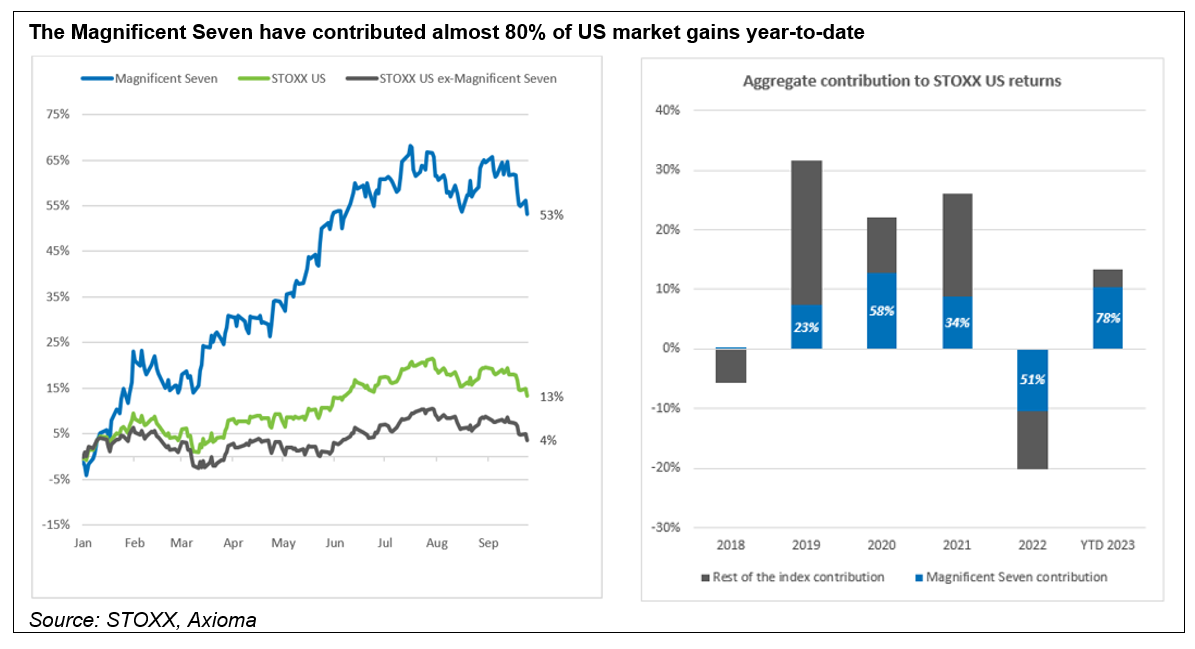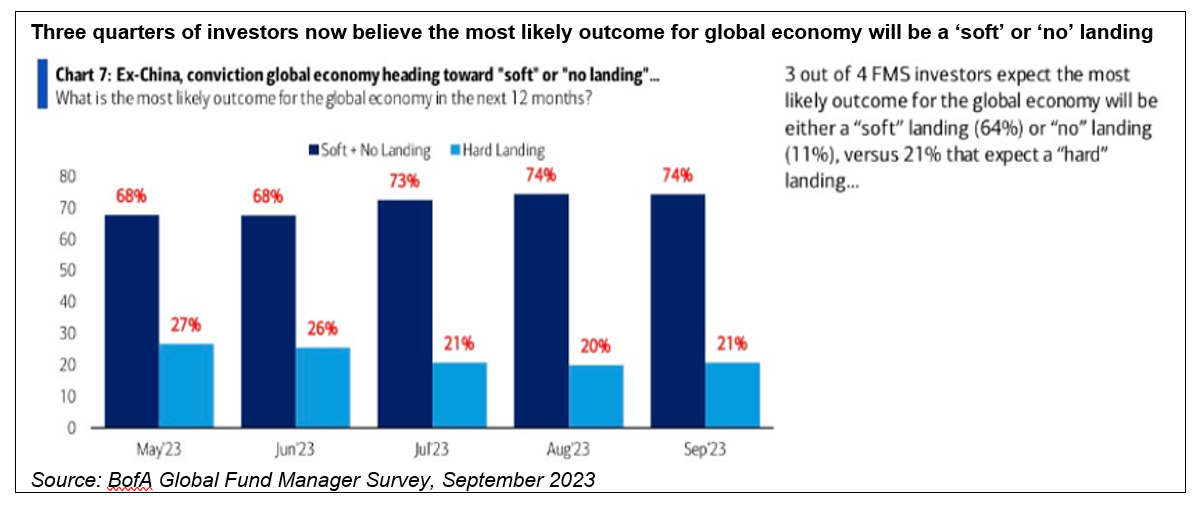In the US, where interest rates have risen to their highest since 2008, the Economic Surprise Index has registered the most positive shocks this year for almost two decades (excluding COVID).
Facing tough economic conditions (and with global equities having just delivered their worst 12-month return for 15 years), few expected positive stock market performance at the start of the year. The Fear & Greed Index of market sentiment was flashing ‘Fear’, fund managers were overweight bonds[1] and the put/call ratio – a sign of investor nervousness – was at all time high. Fast forward to the end of September, however, and global equities have posted year-to-date EUR gains of 11% (and an even more surprising 19% in NOK terms).
Likewise, not many commentators expected high growth technology companies to outperform in a sluggish environment of rising interest rates and fewer still could have predicted that much of the market’s rise would be attributable to so few stocks. Yet, the seven largest companies have generated around four fifths of the S&P 500’s 13% gains this year – also a new record.

Strong fund performance
These narrow market returns mean that my optimism at the start of the year for value to outperform growth has (so far) proven to be misplaced with growth leading by 16 percentage points[2]. Such high concentration in a few big companies has also made it harder for stock pickers to beat the market but I’m happy to report that four of our five equity funds are ahead of their benchmarks year-to-date (and over the past 12 months). In keeping with our longer-term investment horizon, it is also very pleasing that most of our funds are also beating their indices over 3 and 5 years. You can read more about the funds’ recent performance drivers and portfolio activity in our latest quarterly reports.
Since my last update when I discussed the risks posed by the unbalanced stock market and uncertain economic outlook, I am now more optimistic. The S&P 500 index is down 7% from its summer peak (3% shy of a technical correction) and the stocks doing the heavy lifting faded in the third quarter. Each of the Magnificent Seven performed much worse in share price terms than the previous six-month period as valuations contracted and only three delivered positive returns. This saw growth underperform by three percentage points[3] over the quarter, although value continues to trade at close to a 30-year low in relative terms and retains huge upside[4].
The macroeconomic picture also appears clearer and inflation continues to fall. Many people (me included) now believe that the Fed could pull off a soft landing. Investors finally seem to understand that they will do whatever it takes to slow rising prices but importantly inflation expectations have not become unhinged as they did in the 1970s.

Helped by rising long-term bond yields, the Fed recently signaled that the current cycle of interest rate rises is over. This doesn’t mean that I expect them to fall significantly anytime soon, however. Inflation remains sticky and looks unlikely to reach the central bank’s 2% target as September’s higher-than-expected figure demonstrated. Food and lodging costs are still high, and the oil price may rise again, particularly if the terrible situation in Israel escalates or expands across the Middle East.
It is also easy to imagine that central banks are wary of ever returning to an environment of ultra-low borrowing costs given recent experience and the unintended consequences of encouraging speculation in high-risk cryptocurrencies, SPACS and meme stocks.
An environment of positive economic growth and higher interest rates should continue to favour value over growth given the tailwinds for sectors such as financial services, energy, materials, industrials and consumer staples, and headwinds for those like IT. By extension, it also advocates active stock picking as the concentration risk faced by passive investors remains at a record high[5]. The Magnificent Seven now represent 28% of the S&P 500 index and the unhealthy valuation gap between its largest 10 stocks and the rest is still at its widest since the dot com bubble (with the exception of the pandemic).
A word of caution
Before signing off, a few things could derail my cautious optimism. Higher oil prices may refuel inflation, in turn causing further interest rate rises and slower economic growth. The volatility in credit markets, where 10-year bond yields recently hit a 16-year high, could spill over to the financial sector as we saw earlier this year. Finally, geopolitical tensions around the globe are intensifying once more which could see investors flee risky assets in favour of safe havens.
As always with investing, there are risks and rewards for those who can navigate them successfully. There will also inevitably be further surprises along the way – both positive and negative – but I am confident that our experienced and level-headed portfolio teams will stay on course for our clients.
[1] Source: Bank of America Global Fund Manager Survey, December 2022.
[2] Source: MSCI. MSCI ACWI Value +3.2% vs. MSCI ACWI Growth +19.1% in EUR
[3] Source: MSCI. MSCI ACWI Value +1.2% vs. MSCI ACWI Growth -2.0% in EUR.
[4] Source: Bloomberg, MSCI. MSCI US Value Index P/E vs. MSCI US Growth Index P/E.
[5] Source: JP Morgan. 31.9% weighting of the top 10 stocks in the S&P 500 Index as at 30 September 2023.




